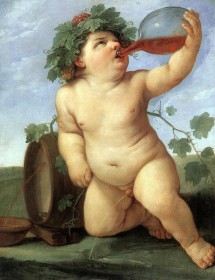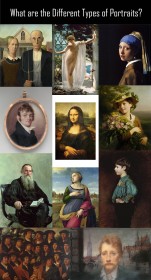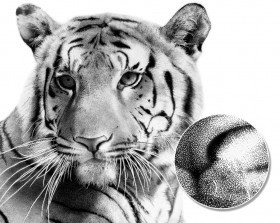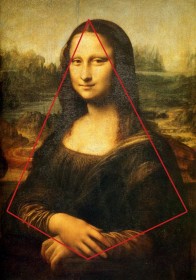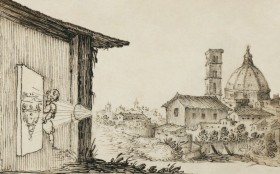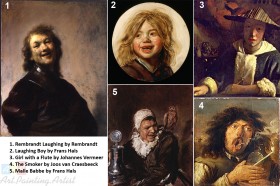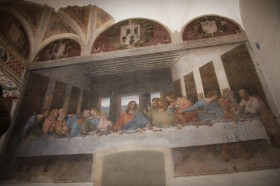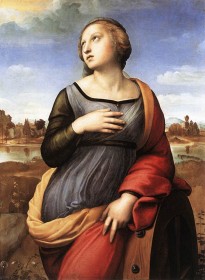Jargons of the art world is a popular series explaining the difficult terms and jargons used in the art world since the renaissance period. We have reached article number 8 in the series and here are the 10 new jargons explained in simple way. 1. Grand Manner Grand Manner, in simple terms, means the subject getting highly emphasized through factual changes, grandeur settings, special poses or overall grandeur composition to make the whole scene/subject look majestic or magnificent. Grand Manner is said to be a part of History Paintings primitively and later on was also used in Portrait Paintings. Here are two examples in both scenarios. First in History Painting: The Expulsion of Heliodorus from the Temple by Raphael from Vatican and is said to […]
Glossary Archive
Glossary of art terms from renaissance times to the modern art jargon.
1. Hodegetria and Theotokos Hodegetria is a term for paintings of Madonna and Child. The word derived from Greek literally meaning, “she who shows the way”. Such old paintings, especially, before the renaissance were called Hodegetria. The term still exists in the art communities referring Madonna and Child’s painting. Theotokos is the Greek name for Mother Mary. The literal translation is “one who gives birth to god”. So, Hodegetria and Theotokos paintings interrelates in technical terms. Although, it consists Madonna and Child, Hodegetria paintings are a bit different than paintings of Madonna and Child in definition. They include paintings in which Madonna has carried the child Jesus and also points towards Him as the symbol of salvation. Here is out gallery of Madonna and Child […]
If you have seen our rich gallery of portrait paintings, you might have seen many different types of portraits. There are portraits which includes people with different angles, numbers and settings. These variety of portraits aren’t just random compositions of people’s profile. Each and every setting, size are aimed for a predefined effect. According to the person or a group of people intended to be portrayed, the painter evaluates the needs by the person/group’s social importance, visual features, etc. and decides what type of setting, canvas size, theme, color-pallet and type of depiction should be used for the most desired portrayal. To differentiate and understand the varity of portraits, down here we have gathered all the major possible types of portrait painting from the renaissance era […]
1. Iconography In any painting, the process of identifying people and things and also understanding the symbolic use of each object is collectively called as iconography of a painting. Any individual painting’s iconography is, obviously, very important to find out the included people’s identity and the intentions of object’s use in the scene. It also helps to understand the people and society’s beliefs during any contemporary times. Iconography isn’t only about the naming of characters and things. Apart from the basic identifications of characters and things, iconography is much more about finding out the symbolic meanings of things, the hidden symbolism of the art if the artists included something like that and finding out the connection of the painting with other historical things which relates […]
Jargons of the art-world part 5 brings ten more technical terms from the art world including the important ones like the golden ratio, tondo, pyramidal composition and Vincent van Gogh’s four square technique. 1. L’art pompier During the late 19th century, in French art schools and academies, most of the artists followed the then-popular art-style academism. But, there were some modern or artists with new mentalities who refused to paint only in the conventional academism or impressionism. They started to invent their own styles. By the other academic artists, they were started to be called as pompier to shun them down. The literal meaning of the term was Fireman and was used pejoratively towards the small bunch of painters who tried “something new”. There happened to be lots […]
1. Camera Obscura Camera Obscura (dark room) could be said to be the earliest version of photography or capturing-image-on-a-surface to be more precise. The technic of the camera Obscura is the most primitive to capture a scene on a surface. In the method, a flat surface contains a hole in it, through which the light enters and falls on another surface. The image received on the surface is upside down. It could be reversed by a mirror and its precision could be traced. The colors and the details of the scene stay intact. This is the earliest type of image-capturing technique, which grew into being a photography technique and ultimately, in modern world, it is the base of every Camera in the world. Its relation […]
Third installment of the Jargons of the Art-world brings you 10 more technical terms used in the artistic communities. 1. Tronie Tronies were the output of the Dutch Golden Age. Before the Golden Age (17th century) in Netherlands, people were afraid of representing themselves in the portraits. The social pressure made them stand for the portraits in very steady, rigid and emotionless ways. When this barrier was broken in Dutch Golden Age, the fear and restriction were gone and artists began to captures the most hidden emotions of people on their canvases. The subject-person’s importance in the society didn’t matter much. The reason is that they were determined to capture the unique and natural expressions. And this new genre of portraits focusing on the human […]
In the first part of Jargons of the Art-world, we learned about 10 technical terms of the art-world. This second list counts ten more technical terms of art-world. 1. Ubiquitous Gaze In old horror movies, there would be at least one scene in which a portrait of a suspicious woman in a dark room with a little light focusing its eyes is there. The scene is supposed to create horror. I have never felt horror in those scenes but at least this art term Ubiquitous Gaze made me realize why directors often shows paintings as an element of horror. Because, in those portraits, the eyes of the woman (or man) seems to be following us. Regardless to weather we are in room, the eyes always follows […]
There are many unfamiliar words in the world of painting, to which you might come across in an essay or read in a book. The words could baffle a regular art-lover, if not provided the real meaning. Here, under the title of Jargons of the Art-world, we have gathered a list of such jargons of the art-world just to understand those words better for the next time you visit an art-museum. 1. Cartoons Cartoons are basically the references for the big paintings, drawings and frescoes undertook by the artists of the renaissance period. Before executing the final draft, first they would draw or painting the full painting on a small scale i.e. on paper with paint, charcoal, etc. Thus, these scale-correct miniatures would help the […]
The renaissance, the era of the refreshment of the art, the time of rejuvenation in all of the art forms, the time when the world saw very drastic changes, happenings, upheavals and the transformation of the conventional ethics and orthodoxies into the modern, new art-forms and techniques. In fact, the renaissance period is the core foundation of our today’s conventional ethics in arts. The renaissance period lasted for 300 years and many techniques were found. These new-founded and revolutionary techniques like the first time use of perspective in art, new found colors (ultramarine for example) took the arts to a whole new level. If we look at the arts before the renaissance, they would look more immature and unrealistic. The art works from renaissance and […]




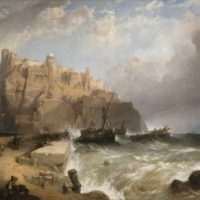

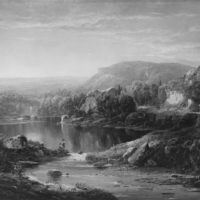
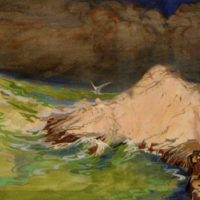
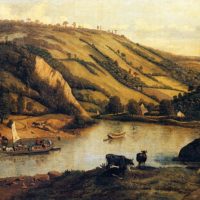

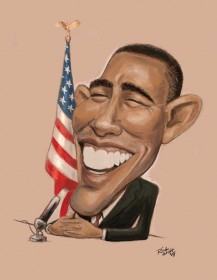

 (1 votes, average: 4.00 out of 5)
(1 votes, average: 4.00 out of 5)